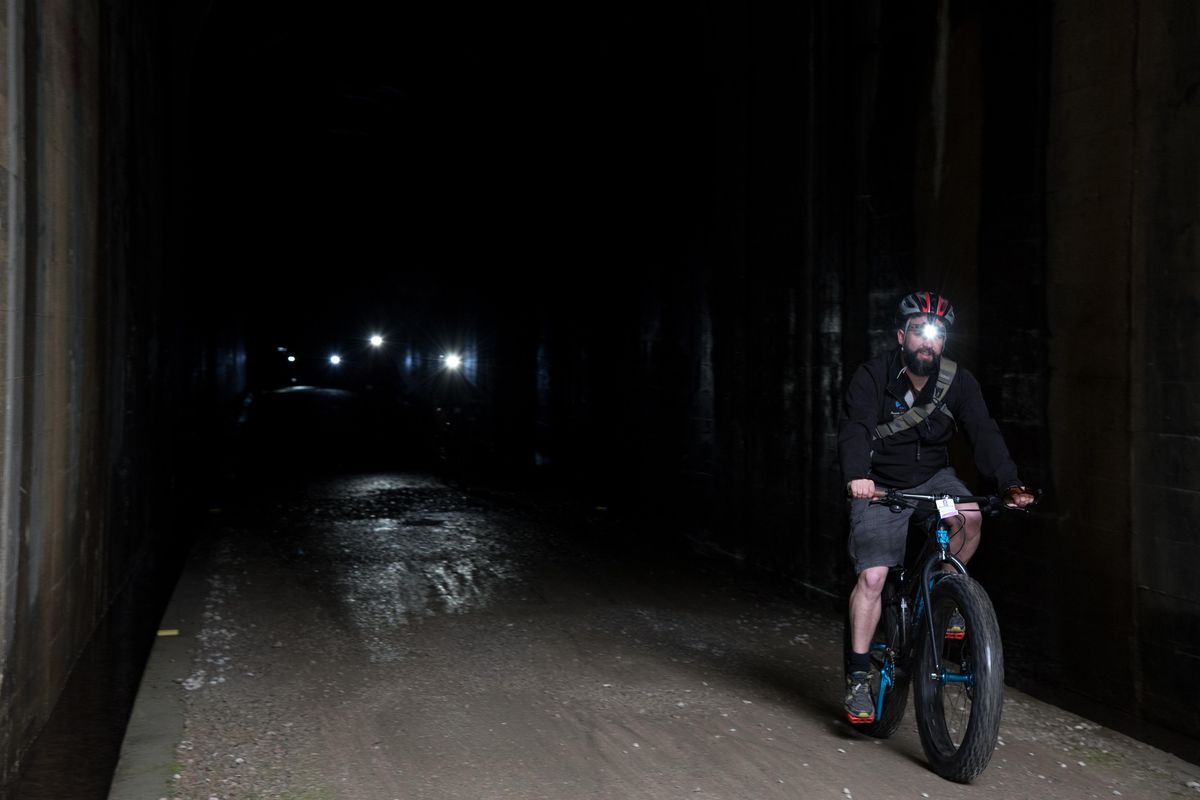North Idaho’s scenic 15-mile Hiawatha Trail celebrates its 20th year

Cigarette in one hand and mountain bike in the other, Greg Ebersohl happily waited for a bus to pick him up in the woods of North Idaho.
“Oh it was great,” he said of the 15-mile mountain bike ride he’d just completed Saturday. “You don’t have to be in great shape.”
Ebersohl had just finished the famed Hiawatha Trail, which is celebrating its 20th birthday this year.
The 15-mile trail is built along the former Milwaukee Road railroad. Winding through the Bitterroot Mountains, the trail allows users to follow the gentle 1.6-percent downhill grade through 10 impressive tunnels and across seven gut-clenching steel trestles. For those who don’t want to bike uphill, or are new to biking, a shuttle service ferries riders from the bottom of the trail back to the starting point.
And that’s what allowed Ebersohl and his riding partners Renee Fischer, Chelle Keplinger and Linda Rogers, to complete the trail despite having not ridden a bicycle in years.
“It was really neat. I could have been a little warmer,” Fischer said. “I haven’t ridden a bike in so long.”
The Hiawatha Trail has been introducing people to the wonders of trail riding for two decades. On Saturday the trail and key players in the creation of the trail celebrated that milestone and the 50th anniversary of the National Trail System Act.
When the trail was first conceived in the 1990s, the project faced significant challenges. The last train passed down the line in 1980 and the infrastructure was aging. Plus any trail effort would require cooperation and coordination between two states, the U.S. Forest Service and local municipalities.
For example, to satisfy safety concerns, the U.S Forest Service asked for about $1 million in improvements before green lighting the trail.
Yet with the support of local trail advocates, politicians in Idaho and Montana and Forest Service employees, the trail opened in 1998.
“What really got it going was this group of rabble rousers in Wallace,” Jaime Schmidt said jokingly at Saturday’s anniversary event. “That citizen advocacy really got it going.”
Schmidt is the national trail manager for the Forest Service. From the beginning she was involved in the creation of the trail.
Twenty years after opening, the trail’s annual ridership has grown from 8,600 visits in 1998 to more than 40,000 visits in 2017.
“The route of the Hiawatha is an outstanding example of a private-public partnership,” said Phil Edholm, president and CEO of Lookout Pass Ski and Recreation Area.
The trail was named to the Rails to Trails Conservancy’s national hall-of-fame list in 2010. And it has been seen as a model for other rail-to-trail efforts both locally and nationally.
Bob Whittaker, chairman of the Ferry County Rail Trail Partners, said the Hiawatha Trail was a guide stone for Ferry County rail-trail efforts.
“It was inspirational for us to see a very rural community come together to simultaneously create public space, preserve habitat and grow the region’s recreation economy,” he said in an email.
Part of the trail’s charm is the care taken to preserve the historic flavor. For instance, trail signs documenting the history of the place mimic the look and feel of railroad station signs. The snow awnings covering the entrance and exits of each tunnel have been built out of the same materials and in the same manner as what would have been used in the early 1900s.
The history is part of the trail’s allure.
In 1907, the construction of the rails started after receiving approval from the Milwaukee Railroad board of directors. The railroad was to run from Chicago to the Seattle-Tacoma area, crossing through some of the wildest and roughest terrain in the United States. Crews worked year-round, even slogging through the North Idaho winters. More than 9,000 men worked on the extension line.
The project was estimated to cost $45 million but ended up costing more than $235 million (more than $6 billion in today’s dollars). The line opened to intercontinental freight service on July 4, 1909, with passenger train service starting six days later.
But the railroad struggled. A devastating forest fire in 1910 marred the railroad’s early life and financial troubles persisted. The Milwaukee Road company went bankrupt several times, finally folding in 1977. In 1961, the last passenger train made the journey and the final train traveled the tracks in 1980. The federal government took over management of the rails in the mid-1980s.
At first the U.S. Forest didn’t know what to do with the abandoned tracks, Schmidt said. That’s when “energized and passionate folks in the Silver Valley” started to lay out a vision for the railroad.
And yet as successful as the last 20 years have been, Schmidt said the rail trail is facing financial challenges. According to forest service estimates, the trail needs between $6 and $7 million in deferred maintenance.
The tunnels and trestles need constant maintenance and inspections.
Current federal funding won’t cover that work. Schmidt is hopeful that funding can be secured in alternate ways – whether that’s through fund raising by nonprofit organizations or through community donations.
On Saturday, Schmidt watched men, women, children and at least one person in an electric wheelchair ride the trail, many for the first time.
“It really does attract the whole range,” she said. “From literally children just out of their training wheels all the way up to folks who have said ‘Man I haven’t been on a bike in decades.’ ”